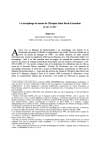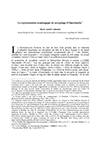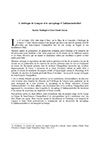sarcophage
« Le sarcophage du musĂ©e de l’Hospice Saint Roch Ă Issoudun (n° inv. 11.55) »
ENiM 7, 2014, p. 13-32.
 Étude du sarcophage anthropomorphique n° inv. 11.55 du Musée d’Issoudun (France) (XXIe dynastie). Il appartient à une chanteuse d’Amon-Rê, roi des dieux, et musicienne du chœur de Mout, la Grande, maîtresse de l’Ichérou, dont le nom reste inconnu. Les inscriptions recouvrant le cercueil sont présentées, accompagnées d’une description iconographique.
Étude du sarcophage anthropomorphique n° inv. 11.55 du Musée d’Issoudun (France) (XXIe dynastie). Il appartient à une chanteuse d’Amon-Rê, roi des dieux, et musicienne du chœur de Mout, la Grande, maîtresse de l’Ichérou, dont le nom reste inconnu. Les inscriptions recouvrant le cercueil sont présentées, accompagnées d’une description iconographique.
 Study of the anthropomorphic sarcophagus no inv. 11.55 of the Issoudun Museum (France) (XXIst dynasty). It belongs to a singer of Amon-Ra king of the gods, and musician in the choir of Mut, the Great, mistress of the Isheru, whose name is unknown. The inscriptions covering the coffin are presented with an iconographical description.
Study of the anthropomorphic sarcophagus no inv. 11.55 of the Issoudun Museum (France) (XXIst dynasty). It belongs to a singer of Amon-Ra king of the gods, and musician in the choir of Mut, the Great, mistress of the Isheru, whose name is unknown. The inscriptions covering the coffin are presented with an iconographical description.
 Consulter cet article (39963) -
Consulter cet article (39963) -  Télécharger cet article au format pdf (22028)
Télécharger cet article au format pdf (22028)
« La reprĂ©sentation cosmologique du sarcophage d’Ourechnefer »
ENiM 10, 2017, p. 25-50.
 Le dessus du couvercle du sarcophage d’Ourechnefer, conservé au Metropolitan Museum of Art de New York sous le numéro d'inventaire 14.7.1b, est le support d’une représentation cosmologique unique à ce jour. L’espace délimité par le corps de la déesse Nout arc-boutée à l’image de la voûte céleste, est occupé par un immense cercle qui constitue le centre de la représentation. Il est surmonté par une figure féminine ouvrant les bras alors qu’il est soutenu par une paire de bras levés prenant appui sur une paire de jambes. Ce cercle, constitué d'un centre et de deux anneaux concentriques, représente non seulement l’Égypte et ses régions limitrophes mais aussi un espace mystérieux en relation avec l’au-delà et la régénération. L’ensemble de la représentation est, selon nous, une interprétation de la première heure du Livre du jour, illustrant la déesse Nout mettant au monde le soleil et donc le cosmos. Cette création iconographique, aux multiples niveaux de lecture, témoigne d’une conception du monde élaborée dans laquelle cosmogonie et cosmologie se rejoignent.
Le dessus du couvercle du sarcophage d’Ourechnefer, conservé au Metropolitan Museum of Art de New York sous le numéro d'inventaire 14.7.1b, est le support d’une représentation cosmologique unique à ce jour. L’espace délimité par le corps de la déesse Nout arc-boutée à l’image de la voûte céleste, est occupé par un immense cercle qui constitue le centre de la représentation. Il est surmonté par une figure féminine ouvrant les bras alors qu’il est soutenu par une paire de bras levés prenant appui sur une paire de jambes. Ce cercle, constitué d'un centre et de deux anneaux concentriques, représente non seulement l’Égypte et ses régions limitrophes mais aussi un espace mystérieux en relation avec l’au-delà et la régénération. L’ensemble de la représentation est, selon nous, une interprétation de la première heure du Livre du jour, illustrant la déesse Nout mettant au monde le soleil et donc le cosmos. Cette création iconographique, aux multiples niveaux de lecture, témoigne d’une conception du monde élaborée dans laquelle cosmogonie et cosmologie se rejoignent.
 The top of the lid of the Wereshnefer sarcophagus, preserved at the Metropolitan Museum of Art in New York under inventory number 14.7.1b, is the support of a single cosmological representation to this day. The space delimited by the body of the goddess Nut, as curved as the celestial vault itself, is occupied by a huge circle which constitutes the representation center. Above it, stands an arm opened female figure while it is supported by a pair of raised arms resting on a pair of legs. This circle, consisting of a center and two concentric rings, represents not only Egypt and its neighboring countries but also a mysterious space in relation to the beyond and regeneration. The whole representation is, in our opinion, an interpretation of the first hour of the Book of the Day, illustrating the goddess Nut bringing the sun into the world and therefore the cosmos itself. This iconographic creation, with multiple levels of reading, testifies to a conception of an elaborate world in which cosmogony and cosmology meet.
The top of the lid of the Wereshnefer sarcophagus, preserved at the Metropolitan Museum of Art in New York under inventory number 14.7.1b, is the support of a single cosmological representation to this day. The space delimited by the body of the goddess Nut, as curved as the celestial vault itself, is occupied by a huge circle which constitutes the representation center. Above it, stands an arm opened female figure while it is supported by a pair of raised arms resting on a pair of legs. This circle, consisting of a center and two concentric rings, represents not only Egypt and its neighboring countries but also a mysterious space in relation to the beyond and regeneration. The whole representation is, in our opinion, an interpretation of the first hour of the Book of the Day, illustrating the goddess Nut bringing the sun into the world and therefore the cosmos itself. This iconographic creation, with multiple levels of reading, testifies to a conception of an elaborate world in which cosmogony and cosmology meet.
 Consulter cet article (38229) -
Consulter cet article (38229) -  Télécharger cet article au format pdf (19417)
Télécharger cet article au format pdf (19417)
« L’obĂ©lisque de Louqsor et le sarcophage d’ÂnkhnesneferibrĂŞ »
ENiM 10, 2017, p. 51-88.
 Des papiers non publiés de Jacques-Joseph Champollion-Figeac conservés à Grenoble, aux Archives départementales de l’Isère, permettent de mettre en lumière de nouvelles informations à propos de l’expédition française de 1830 envoyée à Louxor, en Égypte, pour rapporter à Paris l’obélisque donné à J.-Fr. Champollion par Méhémet Ali. Pendant leur séjour à Thèbes, les officiers de l’équipe payèrent le drogman Youssouf Kashef pour l’extraction du sarcophage de la Divine Adoratrice Ânkhnesneferibrê à Deir al-Médîna. Il fut transféré en France par les officiers, avec l’obélisque, avec l’intention de le vendre au gouvernement français qui refusa la transaction. En 1836, sans que l’on sache comment, les officiers français purent vendre le sarcophage au British Museum.
Des papiers non publiés de Jacques-Joseph Champollion-Figeac conservés à Grenoble, aux Archives départementales de l’Isère, permettent de mettre en lumière de nouvelles informations à propos de l’expédition française de 1830 envoyée à Louxor, en Égypte, pour rapporter à Paris l’obélisque donné à J.-Fr. Champollion par Méhémet Ali. Pendant leur séjour à Thèbes, les officiers de l’équipe payèrent le drogman Youssouf Kashef pour l’extraction du sarcophage de la Divine Adoratrice Ânkhnesneferibrê à Deir al-Médîna. Il fut transféré en France par les officiers, avec l’obélisque, avec l’intention de le vendre au gouvernement français qui refusa la transaction. En 1836, sans que l’on sache comment, les officiers français purent vendre le sarcophage au British Museum.
 From the unpublished papers of Jacques-Joseph Champollion-Figeac kept in Grenoble (Archives départementales de l’Isère) new informations are brought to light about the French expedition of year 1830 sent to Luxor, Egypt, to bring to Paris the obelisk given to Jean-François Champollion by Mehemet-Ali. During their stay in Thebes, the officers of the team paid the drogman Y?s?f Kashef for the extraction of the sarcophagus of the Divine Votaress Ankhnesneferibr? at Deir el-Medina. They transferred it to France with the obelisk wanting to sell this monument to the French Government who refused the transaction. In 1836, through an unknown way, the French officers were able to sell the sarcophagus to the British Museum.
From the unpublished papers of Jacques-Joseph Champollion-Figeac kept in Grenoble (Archives départementales de l’Isère) new informations are brought to light about the French expedition of year 1830 sent to Luxor, Egypt, to bring to Paris the obelisk given to Jean-François Champollion by Mehemet-Ali. During their stay in Thebes, the officers of the team paid the drogman Y?s?f Kashef for the extraction of the sarcophagus of the Divine Votaress Ankhnesneferibr? at Deir el-Medina. They transferred it to France with the obelisk wanting to sell this monument to the French Government who refused the transaction. In 1836, through an unknown way, the French officers were able to sell the sarcophagus to the British Museum.
 Consulter cet article (37950) -
Consulter cet article (37950) -  Télécharger cet article au format pdf (20225)
Télécharger cet article au format pdf (20225)
ENiM 18 - 2025
4 article(s) - 11 mars 2025.
ENiM 1 à 18 (2008-2025) : 223 articles
4 019 380 téléchargements
8 332 035 consulations.
Index des auteurs

Mots clés

Derniers articles : 
Robert Steven Bianchi
Duplication and Continuity
(ENiM 18, p. 13-36 — 11 mars 2025) 
Frédéric Mougenot
Rénénoutet à la porte de la maison
(ENiM 18, p. 1-12 — 29 janvier 2025) 
CENiM - Mise en ligne des volumes Ă©puisĂ©s : 
 Anne-Sophie von BOMHARD DĂ©cans Ă©gyptiens, CENiM 23, Montpellier, 2020 — (2020)
Anne-Sophie von BOMHARD DĂ©cans Ă©gyptiens, CENiM 23, Montpellier, 2020 — (2020) 
 Jean-Claude Grenier L'Osiris ANTINOOS, CENiM 1, Montpellier, 2008 — (26 dĂ©cembre 2008)
Jean-Claude Grenier L'Osiris ANTINOOS, CENiM 1, Montpellier, 2008 — (26 dĂ©cembre 2008) 
TDENiM - Mise en ligne des volumes Ă©puisĂ©s : 
 Twitter
Twitter 3615145 visites - 4322 visite(s) aujourd’hui - 106 connecté(s)
© ENiM - Une revue d’égyptologie sur internet
Équipe Égypte Nilotique et Méditerranéenne - UMR 5140 - « Archéologie des Sociétés Méditerranéennes » (Cnrs) - Université Paul Valéry - Montpellier III
























 Contact
Contact
 Abonnez-vous !
Abonnez-vous ! Équipe Égypte Nilotique et Méditerranéenne
Équipe Égypte Nilotique et Méditerranéenne UMR 5140 « Archéologie des Sociétés Méditerranéennes » (Cnrs)
UMR 5140 « Archéologie des Sociétés Méditerranéennes » (Cnrs) Université Paul Valéry - Montpellier III
Université Paul Valéry - Montpellier III